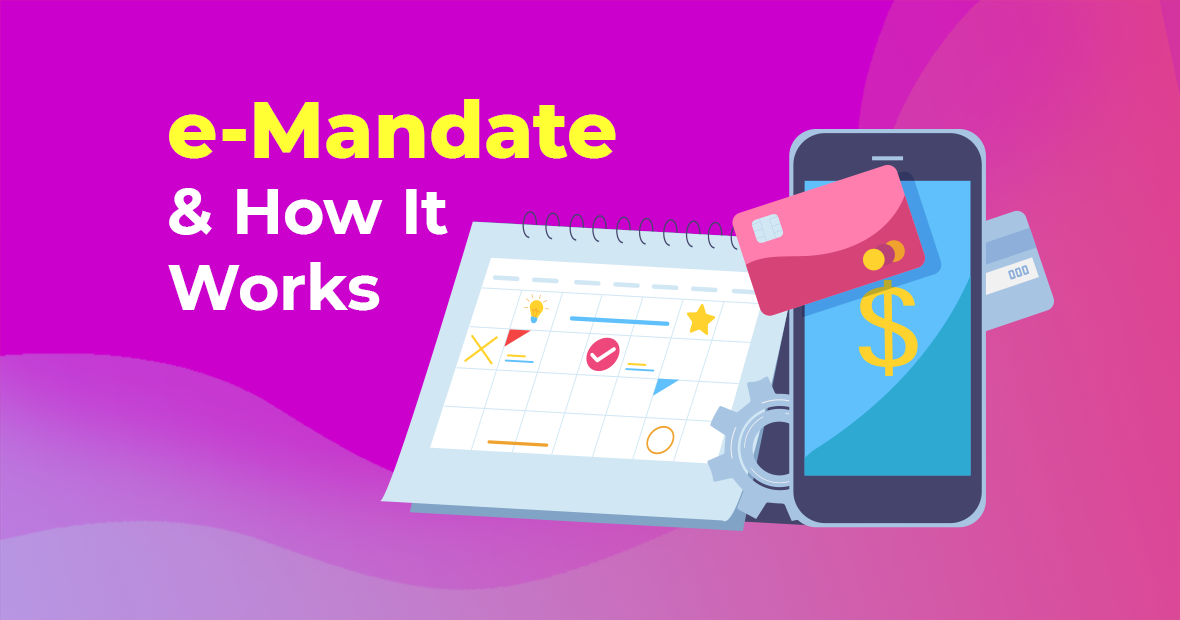- In today's digital era, the convenience of managing finances through online systems has revolutionized the way individuals and businesses handle transactions. One such innovation is the E-Mandate, a digital tool that allows for seamless recurring payments without the need for manual intervention each time. This article will delve into the meaning of E-Mandate, its registration process, how it works, and the associated charges.
What is E-Mandate?
- An E-Mandate is a digital authorization provided by a bank account holder to allow a third party to debit their account automatically at specified intervals. This service is particularly useful for recurring payments, such as utility bills, subscriptions, loan repayments, insurance premiums, and other regular payments. It simplifies the payment process, ensuring that payments are made on time without the need for the account holder to intervene manually.
- The Reserve Bank of India (RBI) introduced the E-Mandate facility to enhance the convenience of digital transactions and ensure better compliance with the regulatory framework for recurring payments. The system is designed to promote the digital economy and reduce the reliance on paper-based mandates, which were often cumbersome and prone to delays.
Key Features of E-Mandate:
- Automation: E-Mandate allows automatic debiting of the specified amount on the scheduled dates without the need for the account holder to remember due dates.
- Flexibility: Users can set up the frequency of payments, whether weekly, monthly, quarterly, or annually, according to their needs.
- Convenience: Users can register and manage their E-Mandates online without the need for physical paperwork.
- Security: The E-Mandate system is governed by strong authentication processes, ensuring that the account holder’s consent is securely captured.
E-Mandate Registration:
How do I activate my e-mandate?
The registration process for an E-Mandate can vary slightly depending on the bank or financial institution involved. However, the following general steps can be followed:
Step 1: Select the Service Provider
- Identify the Service: Determine which service provider/Bank you want to set up an E-Mandate with, such as a utility company, insurance provider, or loan servicing company.
- Check Compatibility: Ensure that the service provider supports the E-Mandate feature.
Step 2: Visit Your Bank’s Online Portal
- Log In: Access your bank’s online banking portal or mobile app.
- Locate E-Mandate Section: Find the section related to E-Mandates or recurring payments. This is often found under “Payments” or “Services.”
Step 3: Fill Out the E-Mandate Form
- Provide Details: Complete the E-Mandate form with details such as:
- Your bank account number
- IFSC code of your bank branch
- Amount to be debited
- Frequency of payments (monthly, quarterly, etc.)
- Duration of the mandate (e.g., till canceled or for a specific period)
Step 4: Authenticate the Mandate
- E-Signature: Depending on the bank, you may need to authenticate the E-Mandate using an OTP (One-Time Password) sent to your registered mobile number or through a digital signature.
- Confirm Registration: Once authenticated, you will receive a confirmation of your E-Mandate registration.
Step 5: Notify the Service Provider
- Inform Provider: Notify the service provider that you have registered for the E-Mandate, providing them with any necessary details they may require to link your mandate to their system.
How E-Mandate Works?
The functioning of an E-Mandate is straightforward and efficient. Here’s how it generally works:
- Authorization: The account holder authorizes the bank to debit their account periodically for a specific amount.
- Payment Schedule: The E-Mandate specifies the payment schedule, including the amount, frequency, and duration of the mandate.
- Debiting Process: On the scheduled date, the bank automatically debits the specified amount from the account holder’s account and transfers it to the service provider.
- Notifications: Depending on the bank's policies, account holders may receive notifications regarding successful transactions or any issues with the mandate.
- Management: Users can manage their E-Mandates through their bank’s online portal, including the ability to modify, pause, or cancel mandates as needed.
Example Scenario:
Let’s illustrate how an E-Mandate works with an example:
- Suppose you have a monthly subscription to an online streaming service that costs Rs. 500. You register for an E-Mandate with your bank, authorizing them to debit Rs. 500 from your account on the 5th of every month. Each month, on the 5th, the bank automatically transfers Rs. 500 to the streaming service without requiring any further action from you. You will receive a notification confirming the transaction.
Advantages of Using E-Mandate:
- Timely Payments: E-mandates ensure that payments are made on time, reducing the risk of late fees or service interruptions.
- Reduced Manual Effort: With recurring payments automated, users no longer need to remember due dates or make manual payments.
- Cost-Effective: E-mandates can reduce transaction costs associated with cheque processing and other manual payment methods.
- Easy Management: Users can easily manage their mandates online, making modifications or cancellations hassle-free.
- Enhanced Security: The E-Mandate system follows strict authentication protocols, ensuring the security of transactions.
Charges Associated with E-Mandate:
While E-Mandates offer numerous benefits, it is essential to be aware of any charges that may be associated with their use. Here are some common charges that you might encounter:
- Registration Fees: Some banks may charge a nominal fee for registering an E-Mandate. This fee can vary by bank.
- Transaction Fees: Banks may impose charges for each transaction processed through the E-Mandate system. This fee is often lower than traditional transaction methods.
- Service Provider Charges: Depending on the service provider, there may be additional fees for using E-Mandates for payments (e.g., subscription fees).
- Failed Transaction Fees: If a transaction fails due to insufficient funds or other reasons, banks may charge a penalty fee.
Conclusion:
- E-Mandate has emerged as a game-changer in the realm of digital payments, providing individuals and businesses with a hassle-free way to manage recurring payments. By automating the payment process, E-Mandates enhance convenience, reduce manual efforts, and ensure timely payments. The registration process is straightforward, and the security measures in place make it a reliable choice for managing financial commitments.
- However, users should always be mindful of the associated charges and select service providers and banks that offer competitive fees. As technology continues to evolve, E-Mandates are likely to become an even more integral part of how we manage our finances in the digital age.
FAQs:
What is the meaning of e-mandate?
- Electronic Mandate (e-Mandate) is a digital standing instruction enabling banks to automatically debit a specific amount from your bank account for recurring payments. This ensures hassle-free transactions for services like loan EMIs, utility bills, subscriptions, and insurance premiums.
What is the e-mandate process?
- To set up an E-Mandate, customers fill out a form available on the website, app, or merchant store. After completing the form, they need to authenticate themselves using Net Banking credentials, Credit or Debit Card details, or other methods provided by their bank.
Why is NACH crediting money from my account?
- NACH credits money from your account based on authorized electronic mandates. This automated process ensures seamless transactions, often used for recurring payments like loan EMIs, subscriptions, or bills.
How do I stop an e-mandate payment?
- To stop an e-mandate payment, contact your bank immediately, providing details of the mandate. They will guide you through the process, which may involve submitting a written request or using online banking services.
Does e-mandate debit money?
- Yes, an e-mandate facilitates automatic debit of money from your bank account, as authorized. It is commonly used for recurring payments like subscriptions, loan EMIs, or utility bills.
How can I check my e-mandate?
- To check your NACH status, contact your bank or log in to your online banking account. Look for transaction history, mandates, or electronic payment sections for relevant information.
What is the minimum amount of the E-mandate?
- You can register both existing and new bank accounts for the E-Mandate facility. Mandate Limits:-
- Minimum Amount: Rs. 5,000
- Maximum Amount: Rs. 1 crore
Can I cancel an e-mandate?
- To withdraw or cancel an E-Mandate, you can request your financial institution directly. Alternatively, you can remove the mandate or debit instructions from your bank. In these cases, your withdrawal instructions will be treated as a 'Stop Payment' instruction within the cheque-clearing system.
We hope that you like this content and for more such content Please follow us on our social site and YouTube and subscribe to our website.
Manage your business cash flows and payable/receivables using our Bahi Khata App.


